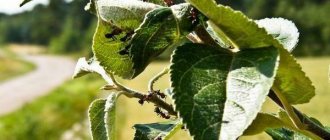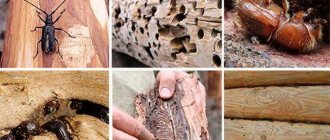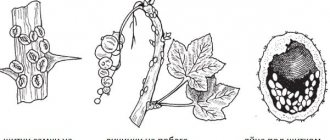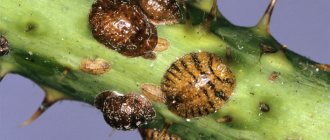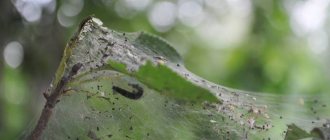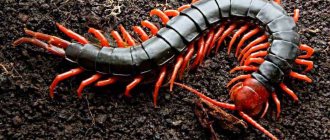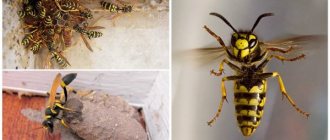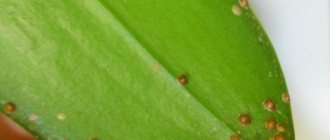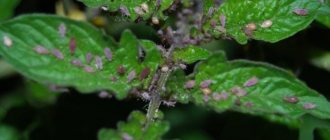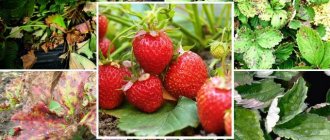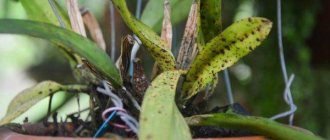5
(1)
Gardening is not about harvesting a long-awaited harvest. Or rather, this is the final part of the work that has to be put in every day throughout the year. Yes, yes, a gardener works all year round - in the fall he prepares trees and bushes for winter, in the winter he protects them from rodents and frost, in the spring he takes care of providing the plants with the substances necessary for growth, in the summer he removes weeds, and protects them from birds. But most of the time during the warm period we have to fight insect pests. In this article we will tell you why scale insects appear on apple trees and how to fight them using folk and chemical treatment methods.
How to recognize an enemy in the garden
There are several types of scale insects. They are called that because of their peculiar waxy shell. It reliably protects them from enemies and various drugs.
Scale insects on apple trees are a fairly common pest, which, if possible, should be combated as early as possible.
The two sexes differ significantly. Females do not have wings, legs, and some species do not even have eyes. The scutellum of females is more convex and has a rounded shape. Due to the lack of legs, females do not move. The size of males is slightly smaller; they have wings, eyes, and limbs. The shell of males is elongated. Males also have oral organs. When the breeding process is completed, the males die.
How to deal with scale insects in the garden on plum, cherry and other trees
The scale insect is a small insect, a pest of garden and vegetable crops, surprising with its camouflage capabilities. There are various methods of combating scale insects on trees in the garden, both traditional and chemical, which will help get rid of it.
Scale insects and its types
The peculiarity of this insect is manifested in the presence of a protective shield consisting of the remains of the larvae’s scales, glued together with its secretions. Externally, such a shell is very similar to irregularities in the surface of tree bark, which makes visual detection of the pest difficult.
The size of the insect does not exceed 5 mm, its main activity is sucking juices from plants, so it is necessary to fight scale insects in the garden, otherwise, when it multiplies en masse, the bark, fruits and ovaries on the tree will be covered with scatterings of these pests. Insects also secrete honeydew, which becomes a breeding ground for sooty fungi, causing the affected plants to gradually dry out and die.
Signs of a scale insect settlement:
- yellow spots appear on the leaves, then they turn yellow completely, curl and fall from the branches;
- the bark cracks, thin and thicker branches begin to fall off;
- the growth of the tree is inhibited, which can lead to its complete drying out and death.
Weakened trees are most susceptible to scale infestation; their appearance is also affected by excess nitrogen fertilizers, insufficient lighting of plants, lack of moisture, and dry air.
Types of garden scale insects
There are a huge number of species of scale insects known - about 2,500. The vast majority of them infect plants that are grown indoors or in greenhouses. Plants growing in open ground are threatened by only a few species of scale insects. Read also the article: → “Ways to combat scale insects in the garden, tips for treating trees.”
This photo shows a close-up of the Californian scale insect.
There are several types of scale insects:
| Name | Description of females | Description of males | Signs of defeat |
| Californian | The shields are round in shape. Color – gray, sometimes brownish. Body up to 0.2 cm long, flat, lemon-colored. | The shells are grayish, oval in shape. Their size is 1 mm. The body of males is light orange. | First, oblong cracks appear on the branches and trunk. Then cracks located in the transverse direction are added to them. Red spots form on the fruits and leaves. They merge over time. 2-3 years after infection, young plants die. |
| mulberry | The size of females is 0.2 cm. The scutellum is rounded, white, less often gray. The body is light orange or yellow in color. | Males have an oblong white shield, on which there is a pair of longitudinal grooves. The body of adult males is approximately 1 mm long and yellow in color. They have a pair of wings, legs, and antennae. | The plant weakens, the fruits appear much smaller in size. Due to the appearance of stains, they become unsuitable for food and sale. |
| Purple | Females are 1 mm long. Their body is oval, almost pentagonal in shape, and purple in color. The scutellum is white, up to 2 mm in size. | Males are winged and reddish-violet in color. Their size is approximately 1 mm. The scutellum is whitish in color, flat in shape, smaller in size than the body. | Affects terrestrial plant organs. The pest can be noticed first along the main vein of the leaves and on the stalk. After the insect appears, the leaves begin to discolor. The fruits lose their commercial quality due to the appearance of purple-red spots on them. |
| Comma apple | The body itself is less than 1 mm in size and has a pear-shaped shape. The scutellum is oblong, brown. | Males are winged. At the top of the abdomen they have a long process. The color of males is reddish-gray. | Infestation is indicated by spots that appear in the places where the pest has settled. |
| Oyster | The body is short oval. May have a lemon or greenish-yellow color. The color of the scutellum is grayish-olive. The shape is slightly flattened in the central part. | Males are winged - yellowish-orange. They have a black band on their back. The scutellum is about 1 mm in size, short-oval. | They usually affect leaves, branches, and trunks, located on their undersides. Fruits are rarely affected. |
Appearance of scale insects and lifestyle
The scale insect is a very interesting insect. And highly specialized. An adult scale insect looks like a small growth, a plaque on a shoot, leaf, or even on the fruit of a plant. At first, you might not even pay attention to such a trifle - you never know what kind of scale has grown on the branch! And this turns out to be a very dangerous pest.
Is scale insects dangerous for humans? No, it's absolutely not dangerous. Neither humans nor domestic animals are interested in scale insects at all. She is an exceptional vegetarian!
The body of the scale insect pest is covered with a shell consisting of skins after molting of larvae of the first and second instars, sealed with a special secretion. The edges of this shell are pressed very tightly to the surface of the plant. Therefore, the impression of monolithicity is created.
Adult scale insects lead a sedentary lifestyle. Having stuck in one place, they do not move anywhere else. The shield may be glad to change its location, but it cannot. Since the imago has no limbs, they atrophy. And it can move only at the larval stage.
However, even after sticking to one place, the scale insect causes significant damage to the tree. The insect feeds on the juices of the plant and, in large concentrations, these pests can even lead to the death of a young tree. Or to its significant weakening. And also spoil the harvest well.
comma-shaped (apple) scale insect photo
How to determine plant damage
First of all, you can recognize a lesion by the appearance of plaque. It is sticky and very similar to syrup. Gardeners call this coating honeydew or honeydew. These secretions are left by sucking insects - one of the types of scale insects. The very first harm from this is serious damage from sooty fungus, which actively develops in the secretions.
This photo shows a close-up of the false scale insect; this pest can appear not only on the apple tree, but also on other fruit plants.
If plaque appears, you need to carefully examine the plants, especially the trunks and branches. You may notice off-white or grayish-brown plaques on them. These are adult larvae and females sucking the juices from the plant. Within a year after infection, new tissue will begin to grow in the damaged areas. Because of this, the surface of the bark becomes lumpy.
The leaves on the tree or bush will begin to turn red, become deformed and then fall off, and the plant itself will stop growing and developing. If nothing is done, in the third year the infected branches will begin to dry out en masse and the bark will crack. During this period, it is unlikely that it will be possible to effectively combat the pest: the defeat will be massive, and the damage has already been significant. It is best to prevent this and begin exterminating the scale insect as soon as it is noticed on the site.
Comma-shaped scale
It is found in any region and affects apple, plum, pear and even currant bushes. Does not ignore rowan and hawthorn. On the bark of affected trees, small scutes can be seen, shaped like commas. The female is located in the narrow part of such a shield.
The larvae are yellow in color and have red eyes. They leave their scutes and spread throughout the plant within a couple of weeks.
By sucking juices, the scale insect harms the plant. It can develop to such an extent that it covers branches and trunks with a continuous carpet. Over time, the affected areas of the bark die, the foliage falls off, and the young shoots dry out. The tree loses its resistance to winter and does not resist bark beetles and black cancer.
False California parasite
Harmful not only to fruit trees. It is capable of infecting hawthorn, willow, poplar, linden and yellow acacia. The shape of the insect is round or oval, the scutes are of two shades.
The larvae overwinter on tree bark. As summer approaches, the emerging females lay eggs. The emerging larvae crawl throughout the tree and stick to the bark.
Willow scale
It is more often found in northern places. It lives on currant, raspberry or gooseberry bushes, but is quite populated on aspen, rowan, bird cherry and other trees. The shields are flat in shape and resemble lime splashes in appearance.
The laid eggs overwinter under the scutes of dead females. The larvae become mobile during the currant flowering season and quickly spread throughout the plant. If the number of insects is high, then they are able to cover the branches with a continuous cover of a gray shade.
Acacia or common false shield
Found on grapes and other stone fruits. The shape is a semicircular shield of a reddish color. Females attach themselves to last year’s shoots from which they can receive food and the shell hardens. They lay new offspring underneath. After the death of the female, the shield serves as protection for small scale insects. In May, young scale insects hatch from the laid eggs and spread throughout the plant on the underside of the leaves. In the fall they move to annual shoots and spend the winter there without protection. In the spring they become sexually mature individuals.
Methods of control and protection of the garden from pests
- The main method is mechanical cleaning of the bark using brushes with metal bristles. This makes it possible to destroy the scutes and all the eggs hidden under them as much as possible. If there are areas that are most severely affected by willow scale, then it is recommended to remove and burn such shoots.
- Scale insects that appear on young seedlings are removed mechanically using the washing method with simple laundry soap. In this case, it is recommended to spray the upper areas of the soil with toxic preparations or even replace them completely.
- Older trees are much more difficult to wash. For this reason, they are scraped with brushes and additionally treated with insecticides. Actellik is best suited when used in the fight against aphids, whiteflies, and mites.
- If the number of larvae is high, it is allowed to spray with a soap solution to which calcined salt has been added. People use onion, garlic or tobacco infusions, as well as decoctions of celandine, pine needles, and yarrow.
- Auxiliary control measures include the timely use of complex fertilizer compositions, thinning crowns, removing dried branches, and digging up the soil.
To prevent possible infection with scale insects, it is recommended to purchase plant seedlings from special nurseries that guarantee the complete absence of parasites.
Causes of infection of garden trees
Usually the scale insect gets into the area with newly acquired seedlings or grafting material. Sometimes their larvae are carried by birds or the wind (if the affected trees are not very far away).
To avoid this, you need to carefully inspect the cuttings or young seedlings you purchase. Even if nothing was noticeable on them, after planting the trees must be inspected frequently and the entire garden systematically examined. Gardeners recommend paying the most attention to the appearance of plants.
Tip #1. If you notice the slightest changes, red dots, sticky plaque, start treatment immediately.
Scale insect pest on indoor plants: how to fight
The scale insect appears on flowers with purchased plants, cut flowers near potted ones, after airing.
Photo of a pest on different indoor plants
Methods for getting rid of scale insects on an orchid are:
- insulating the plant, increasing air humidity and daily ventilation of the room;
- washing with warm water to remove larvae;
- eliminating ants (wet cleaning with vinegar added to a bucket).
Folk methods of wrestling are:
- denatured alcohol (10 mg of a substance containing alcohol) and liquid soap (15 mg), which are applied to the pest;
- olive oil (2 tbsp per 1 liter of water);
- garlic cut;
- fern decoction (10 g dry or 100 g fresh) boiled for half an hour is used for a week.
The mixture must be applied with a brush or spray. Alcohol solutions are used exclusively on damaged areas.
Scale insects on ficus can also be eliminated manually by washing with a soapy solution and removing infected leaves and twigs. This eliminates infection at the initial stage. Next, you should act with fungicides and insect predators. Pesticides and pepper, garlic and onion infusions have a destructive effect on young pests.
The scale insect pest spreads faster on house plants if the owner, trying to help the cultivated plant, uses growth regulators and especially nitrogen-containing fertilizers.
Preventive control measures
There are several important rules, the observance of which will help preserve the garden and prevent infection:
- Thin out the crowns in a timely manner.
- Constantly remove branches that are dry or damaged. At the same time, it is necessary to remove root shoots and dried trees.
- Clean the bark on skeletal branches and trunks that has fallen away from the trunk or is damaged.
- Properly fertilize and water trees. If the plants are strong, they are rarely affected by pests.
The scale insect usually appears on trees, or rather on poles or branches; sometimes you can see the scale insect on green branches.
Struggle
Prevention
Bearing in mind that it is easier to prevent trouble, we will tell you about preventive measures against scale insects. They are not at all difficult and should be performed in every garden:
- Timely sanitary and rejuvenating spring pruning of apple trees. At the same time, branches that thicken the crown are also cut out.
- Constantly inspect the tree for possible infection, because a small colony of pests is easier to destroy.
- Inspection of seedlings purchased both from a good neighbor in the country, and from specialized stores and fruit nurseries.
- Regular removal of lichens, mosses and peeling of bark, sanitary treatment of tree wounds with recommended preparations, the same garden varnish
Chemicals and other spray preparations
Protected by their shells, scale insects are practically not susceptible to the destructive properties of pesticides. The only time to try sanitization is when the stray nymphs appear. Then their delicate bodies may die from the spraying.
Attention! In addition to the dangerous chemicals with which all the shelves of garden stores are littered, you can also get by with biological preparations, such as Fitoverm.
Basically, the methods of combating scale insects on apple trees are of a mechanical nature. This includes all kinds of bark cleansing and washing with various preparations.
Metal brushes
The brushes that I use to treat rust on metal are perfect for scraping scale insects from plant trunks and branches. Although it must be said that it is better to cut off a severely affected branch and burn it.
Washing
A good effect is obtained by washing the skeletal branches after cleaning with brushes. To do this, you need to use a solution with laundry or tar soap, to which you should add garlic and soda ash.
And for starters, let’s present a video on how to deal with scale insects:
Source of the article: https://beetlestop.ru/shhitovka-na-yablone/
Pest control in various ways
Due to the rapid reproduction of this type of insect, it is very difficult to defeat the pest. In addition, it has excellent protection against toxic chemicals - a shield. But the complexity of the struggle does not mean it is ineffective. To defeat this dangerous insect pest, there are many different methods of action:
- Mechanical. Effective at the initial stage of infection. This option provides that the insect is simply eliminated with swabs or sponges soaked in alcohol. In addition, the affected branches are removed. But they are not left, but must be burned.
- Folk. This option is acceptable when there are still few scale insects on the plant. Trees are sprayed with a solution of pepper, garlic, and celandine. As an option, make an infusion of tobacco, dilute machine oil with a soap solution. Such means will help in the fight against young larvae, but it is unlikely that it will be possible to get rid of adult insects in this way.
- Biological. We are talking about entomophages. They will help get rid of mulberry scale. A biological method is also the use of fungicides that are based on pathogenic nematodes or fungi. Such drugs are Nemabact and Aversectin. These remedies can be effectively combated against the Californian scale insect.
- Chemical. Pesticides are indispensable in the fight against such a serious enemy of gardens. But even potent insecticides may not give the expected result if you do not take into account the development cycle of the scale insect. It is best to use chemicals at the time when the larvae appear - during this period they are vulnerable and can be eliminated.
In this photo you can see what a tree pillar looks like that has been affected by a pest called the comma scale insect.
Fighting methods
Getting rid of scale insects on an apple tree is not easy, since it is covered with a durable shell that can protect individuals even from the effects of chemicals. Therefore, some gardeners prefer to manually clean the surface of the bark and leaves from insects. They are removed from most fruit trees with a scraper or iron brush. If the branch is seriously damaged, you will have to saw it off and burn it along with the scale insect and its deposited larvae.
In young plants, insects are removed not only by mechanical methods. In addition, the trees are treated with a soap solution, which can destroy the larvae.
Before you start fighting scale insects, you should familiarize yourself with several rules:
- first, the trees are treated with non-toxic solutions;
- plants are sprayed 1-2 times a week;
- To improve the effectiveness of the means used, they are used alternately.
Folk remedies
Some try to eliminate pests on apples using special folk remedies. There are several effective remedies that will help cure trees:
- Soap solution. To prepare this mixture, mix 5-7 liters of water with three heads of chopped garlic and laundry soap. Plants are sprayed with the prepared solution five times a week until all parasites die.
- Onion remedy. To create an onion tincture against scale insects, you will have to grate one onion on a fine grater, stir in a liter of water and leave for 5-6 hours. After this, the liquid is filtered and used to spray apple trees.
- Bitter pepper. When creating a solution, add 100 grams of pepper to 2-3 liters of hot water, after which the mixture is infused for 20-30 hours. Then add 20 grams of laundry soap to the filtered tincture.
See also
Description of the Russian apple tree variety, winter hardiness characteristics and yieldRead
Non-chemical means for control
To eliminate apple scale insects, biological control methods are often used, which include:
- wasps that are released onto the branches of apple trees so that they begin to eat dangerous pests;
- a mixture of liquid soap, which should be used to treat the surface of leaves and twigs daily;
- neem horticultural oil, which destroys not only scale insects, but also other insects.
The above methods of control are considered the safest, since they are not capable of harming plants.
Tips from pest control experts
Gardeners who have already dealt with this insidious enemy advise:
- There is no need to collect scale insects by hand - this way only one shield is removed, and the insect itself remains. In addition, almost mature larvae may appear under the shield. Removing the shell will allow them to go free and, as a result, instead of eliminating the enemy, you can get an additional huge number of new individuals.
- You should be very careful with chemicals - strictly follow the instructions and use less toxic drugs first. This will prevent harm to other plants and pets.
- Before you start treating affected plants with chemicals or planting insect predators, you need to thoroughly water everything that grows nearby - bushes, trees and even grass.
Prevention of re-infection
When using preparations for scale insects on fruit and other trees, you need to carefully treat them and prevent their reappearance.
Prevention can be used as the initial method of removing parasites:
- It must be remembered that sexually mature individuals are inactive, which means that it is necessary to stop planting new trees for a while. Especially in close proximity to infected crops;
- buying seedlings from reliable sellers is also a kind of insect control. It must be remembered that most cases of infection occur due to the acquisition of infected seedlings;
- autumn should be accompanied by digging up the soil, and spring by removing the remains of leaves and infected parts of trees and other vegetation.
These simple methods protect the area from the scourge of scale insects. Periodic inspections of the plant will prevent parasites from multiplying and will help preserve the harvest. Fighting scale insects is not an easy task, however, comprehensive control measures have a noticeable effect and allow you to achieve good results.
Source of the article: https://gdeklop.ru/other/kak-izbavitsya-ot-shhitovki-v-sadu-agrotehnicheskie-priemy-i-effektivnye-preparaty/
Features of plant processing
It is not for nothing that scale insects are considered difficult to eradicate pests - thanks to their excellent protection, they can even withstand chemical treatment. Sometimes a scraper or wire brush may be more effective. Mechanical cleaning of tree bark with their help eliminates both adult individuals and eggs hidden under the shell. If the pest colony has grown very large, this method will not help get rid of it.
Tip #2. The only way out is to cut off the infected sections of the branches (and possibly the entire plant) and burn it.
It is easier to eliminate scale insects on infected seedlings: you need to treat them with a brush and then wash them with a solution of laundry soap. To prevent the whole procedure from being useless, experienced gardeners recommend treating the soil around the plants with chemicals or replacing it, which is much more effective.
The photo shows a close-up of a comma-shaped scale insect that has settled on a branch of a fruit tree.
Large trees are more difficult to wash, so after treating them with a brush or scraper, treat them with one of the preparations given in the table below.
| Name | Advantages | Flaws |
| Phosbecid (Aktelik) | The drug can be used to treat seeds. Pests don't get used to it. The drug completely eliminates insects and they do not appear again. | The presence of an unpleasant odor. High toxicity. |
| Aktara | Recognized as an effective drug. Re-infection is prevented. | Unpleasant smell. The drug is dangerous for bees. |
| Bitoxibacillin | Has no smell. The drug is safe, completely harmless to animals and people. This drug consists of live bacteria, which destroy scale insects at all stages of their development. | Re-processing required. Can only be processed when the outside temperature is above +18 degrees. During processing, be sure to use a respirator and wear gloves. |
| 30 Plus | Environmentally friendly product. It is a mineral-oil emulsion created on the basis of petroleum jelly. Removes many types of pathogenic flora and spores of parasitic fungi. | Dangerous for bees. It is allowed to use only in spring, before the flowers have bloomed. |
If the infection is severe, you can treat it after flowering using one of the following means:
- Karbofos.
- Rovikurt.
- Rogor.
Signs and danger of insects for fruit and berry plants
Despite their small size, scale insects can cause enormous damage to garden vegetation. Their danger is that they feed on juices until the shoots die. During the process of infection, the leaves begin to fall off and dry out, this is a sure sign of an attack. Before using chemicals, insects should be removed from protection by mechanical means. Otherwise, chemical treatments will be ineffective.
Most often, you can notice the presence of the parasite in the spring, when small active insects that do not have wax armor appear. In search of food, newborn bugs scamper along tree trunks, branches and foliage. At this moment, it is best to start the fight using chemistry. In this case, adult individuals can be seen attached to the lower part of the leaves, in the places where the leaves adjoin the branches or trunk. Inspecting the leaves, you can see small spots that will also be on the trunks.
Brief description of the pest
Scale insects (Latin name – Diaspididae) are a family of insects found throughout the world. They are known as pests of wild, cultivated and ornamental plants, causing great damage to gardening. Science lists 2,400 species among them, of which the plum, comma-shaped and Californian scale insects most often infect plums. The latter, despite its foreign name, is widespread in Russia, Ukraine, Moldova and other neighboring countries.
Insects reproduce by laying eggs. Soon larvae emerge from them, and then adults. They are characterized by pronounced sexual dimorphism: females are very different from males both in appearance and in the characteristics of their life:
- The body of females is protected by a hard shell - a rounded shield, reaching a diameter of up to several mm. Its color depends on the species and age of the individual. She has no legs, whiskers, wings or even eyes. The female scale insect spends her entire life in one place, clinging to a plum shoot.
- The male looks completely different: he is a small winged midge with antennae, legs and eyes colored purple-red. The male individual circles around the plants, but does not cause them any harm: only females and larvae feed on plant juices.
- The larvae molt several times, gradually becoming similar to adults. They need nutrients to grow, and they suck them from plum shoots. Starting from the second instar of the larva, the male sex appears divided into a head, chest and wing rudiments. Female individuals become overgrown with a dense shield, and their wings and eyes are also reduced.
Scale insects are visually similar to growths on the bark of a plum tree. They live mainly in colonies consisting of insects that differ in age. Single individuals are extremely rare.
California scale insect
Finding the scale insect itself on an apple tree is not so easy.
After all, its size is only 1.5-2 mm. However, this inconspicuous insect is considered a leader among pests of fruit trees and shrubs. In total, there are more than 270 plant species under her “care”. There are practically no natural enemies capable of fighting the scale insect population. This insect wears a kind of shell - a shield, which gradually hardens as the insect grows. Males, unlike females, have eyes and even wings, but their oral organs are completely undeveloped. The juices from the plant are sucked only by the female, equipped with developed mouthparts, with which she pierces the tender shoots and foliage of the plants. It is curious that the female can move only when the scutum is not yet strong enough. After it hardens, the insect becomes motionless.
Scale insects live in large colonies on trees. In 2-3 seasons, insects are capable of destroying fragile seedlings and young apple trees and causing serious damage to an adult plant, sucking the juices out of it and making it vulnerable to the most dangerous disease - black cancer.
Due to lack of nutrition, the leaves of the apple tree begin to fall off prematurely and the skeletal branches die. The bark on the tree begins to crack and then completely separates from the trunk. Fruits covered with red spots begin to shrink and wither. An infected tree is damaged by even slight frosts and quickly dies.
Getting rid of scale insects is not easy - after all, the hard shell reliably protects the insect from exposure even to chemicals. Therefore, the fight against the eggs of these insects must begin in the spring, before the start of sap flow in February-March.
The best drugs for protection against scale insects are nitrophen, DNOC and special mineral oil (it is sold under the name “Preparation No. 30”). After treating the trunks and branches of an apple tree with it, a thin film is formed that prevents the flow of oxygen, and the insects die. Spraying is effective against aphids and mites.
Treatment with karbofos or metaphos is carried out twice, the second time after the hatching of the larvae (“vagrants”), which have a scutum that has not yet hardened, at the end of June, so that at least 30 days remain before harvesting.
